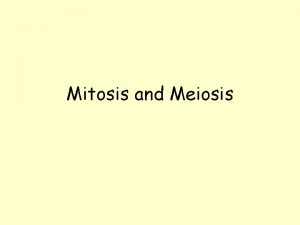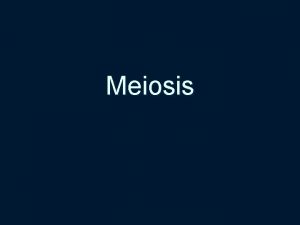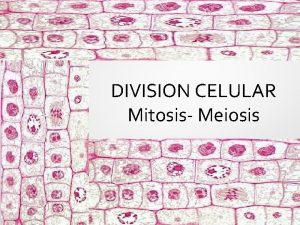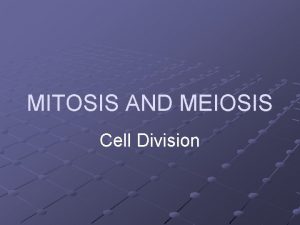Mitosis vs Meiosis Mitosis is the nuclear division






- Slides: 6

Mitosis vs. Meiosis • Mitosis is the nuclear division that takes place in typical cells that allows for 2 cells with identical DNA to made. This occurs in organisms to help with growth, development, and tissue repair or regeneration. • Meiosis is the nuclear division that takes place in the gonads (ovaries and testes) that allows for 4 cells with varying DNA and only one copy (haploid) of each chromosome. These cells created are called gametes.

Meiosis Steps • First nuclear division – 46 X’s (big chromosomes) split into 2 nuclei with 23 X’s (one of each kind of chromosome) • Second nuclear division – 23 X’s split into 2 nuclei with 23 single copy chromosomes much like happens in mitosis. • Cytokinesis follows both divisions, but interphase only follows second division.


Meiosis (Prophase I) • Two pairs of homologous chromosomes = tetrad • Trading chromosome pieces in the pair is called crossing over. This increase variation as you can pass on one chromosome with a piece of the second.

When • Mitosis: throughout life in some cells, but cell division stops in nerve cells and muscle cells early in life (2 -3 years old). • Meiosis: – Females: Begins before two years old, then starts again during puberty with one egg made each month. Menopause is when eggs are no longer formed. – Males: Happens throughout life from puberty to death.

Result • Mitosis: 2 Diploid cells with 46 single copy chromosomes. • Meiosis: 4 haploid cells with 23 single copy chromosomes (one of each kind) – Males: All four are viable cells (sperm) – Females: Of the four cells created, only one will become an egg and the other three becoming polar bodies with little cytoplasm, yet having the full 23 chromosomes.











